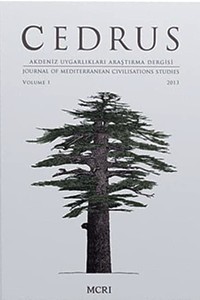Menderes Magnesia’sı Artemis Kutsal Alanı Güney Stoa’dan Bir Kadın Başı
Magnesia ad Maeandrum, Hellenistik Dönem, Mantolu Kadın Heykeli, Adak Heykeli, Heykel Başı
The Head of a Woman from the South Stoa in the Sanctuary of Artemis from Magnesia ad Maeandrum
Magnesia ad Maeandrum, Hellenistic Period, Veiled Female Statue, Votive Statue, Head of Statue,
___
- Aybek S. 2009, Metropolis İonia I Heykel: Metropolis’de Hellenistik ve Roma Dönemi Heykeltıraşlığı. İstanbul.
- Aybek, S., Metropolis (İonia), Hellenistik ve Roma Devri Heykeltraşlık Eserleri, Ankara Üniversitesi, Sosyal Bilimler Enstitüsü, 2003 (Yayınlanmamış Doktora Tezi).
- Bammer A. 1978/80, “Elemente flavisch-trajanischer Architecturfassaden aus Ephesos”. ÖJh 52, 67-90.
- Bergemann J. 1997, Demos und Thanatos: Untersuchungen zum Wertsystem der Polis im Spiegel der attischen Grabreliefs des 4. Jahrhunderts v. Chr. und zur Funktion der gleichzeitigen Grabbauten. München.
- Beschi L. 1988, “Demeter”. LIMC IV/1-2, 844-892.
- Bingöl O. 2007, Magnesia on the Meander = Magnesia ad Maeandrum: the city of Artemis with “white eyebrows”. [an Archaeological Guide]. İstanbul.
- Bingöl O. 2020, Menderes Magnesiası = Magnesia ad Meandrum: 1984-2020. Ankara.
- Bingöl O. & Oral M. 2009, “Magnesia ad Meandrum”. KST 30/4, 385-408.
- Daehner J. M. (Ed.) 2007, The Herculaneum Women. History, Context, Idendities. Los Angeles.
- Delivorias A., G. Berger-Doer & A. Kossatz-Deissmann 1984, “Aphrodite”. LIMC II/1-2, 1-151.
- Dillon S. 2010, The Female Portrait Statue in the Greek World. New York.
- Eule J. C. 2001, Hellenistische Bürgerinnen aus Kleinasien: Weibliche Gewandstatuen in ihrem antiken Kontext. İstanbul.
- Gider Z. 2011, “Doric capitals with Ionic cymation in the light of Examples from Caria Region”. Anados, Studies of the Ancient World 11/2011, 139-148.
- Havelock C. M. 2008, The Aphrodite of Knidos and Her Successors: A Historical Review of the Female Nude in Greek Art. Ann Arbor.
- Hoff R. v. 2007, “Die Plastik der Diadochenzeit”. Ed. P. C. Bol, Die Geschichte der antiken Bildhauerkunst III, Hellenistische Plastik. Mainz, 1-39.
- Humann C., J. Kohte, & C. Watzinger 1904, Magnesia am Maeander: Bericht über die Ergebnisse der Ausgrabungen der Jahre 1891-1893. Berlin.
- Ismaelli T. 2009, Hierapolis di Frigia III: Architettura Dorica a Hierapolis di Frigia, İstanbul.
- Kabus-Preisshofen R. 1989, Die hellenistische Plastik der Insel Kos, Ath. Mitt. 14. Berlin.
- Kaltsas N. 2002, Sculpture in the National Archaeological Museum, Athens. Los Angeles.
- Kökdemir G. 2011, “Menderes Magnesiası – Propylon: Mimari Bezemeler”. Anadolu 37, 93-141.
- Kökdemir G. 2015, “Magnesia Ad Maeandrum: 300 Yıllık Araştırma Tarihçesi “1715-2015”. Anadolu 41, 159-185.
- Kökdemir G. 2019, “Yeni Değerlendirmeler Işığında Menderes Magnesiası’nda Athena Kültü, Panathenaia ve Bilinmeyen Bir Athena (?) Başı”. Cedrus VII, 107-121.
- Kron U. 1996, “Priesthoods, Dedications and Euergetism. What Part Did Religion Play in the Political and Social Status of Greek Women?”. Eds. P. Hellström & B. Alroth, Religion and Power in the Ancient Greek World. Proceedings of the Uppsala Symposium 1993. Uppsala, 139-182.
- Kyrieleis H.1975, Bildnisse der Ptolemäer. AF2. Berlin.
- Linfert A. 1976, Kunstzentren Hellenistischer Zeit: Studien an Weiblichen Gewandfiguren. Wiesbaden.
- Ma J. 2012, “Honorific Statues and Hellenistic History”. Eds. C. Smith & L. Yarrow, Imperialism, Cultural Politics, and Polybius. Oxford, 230-251.
- Magie D. 1950, Roman Rule in Asia Minor to the End of the Third Century After Christ 1/2. Princeton.
- Marcadé J. 1969, Au Musée de Délos: étude sur la sculpture hellénistique en ronde bosse découverte dans l'île. Paris.
- Mattusch C. C. 1996, Classical Bronzes: The Art and Craft Greek and Roman Statuary. Ithaca.
- Mendel G. 1914, Catalogue des Sculptures (2) Grecques, Romaines et Byzantines: II. İstanbul.
- Meriç R. 2003, Metropolis: Ana Tanrıça Kenti. İstanbul.
- Meriç R. 2006, “Metropolis”. Ed. W. Radt, BYZAS 3 – Stadtgrabungen und stadtforschung im westlichen Kleinasien, Geplantes und Erreichtes. İstanbul, 227-240.
- Özgan R. 1982, Yunan ve Roma Devri Tralleis Heykeltraşlığı. Doçentlik Tezi, Selçuk Üniversitesi. Konya.
- Özgan R. 2020, Hellenistik Devir Heykeltraşlığı IV – Geç Hellenistik, Aydın.
- Pinkwart D. 1973, “Weibliche Gewandstatuen aus Magnesia am Mäander”. Antike Plastik 12, 149-159.
- Pollitt J. J. 1986, Art in the Hellenistic Age. Cambridge.
- Prittwitz H. v. 1998, “The Divine Circle: The Roundels of Mahdia”. Eds. O. Palagia & W. Coulson, Regional Schools in Hellenistic Sculpture: Proceedings of an international conference held at the American School of Classical Studies at Athens, 15-17 March 1996. Oxford, 69-73.
- Prittwitz H. v. 2007, “Die hellenistische Plastik von 160 bis 120 v. Chr.”. Ed. P. C. Bol, Die Geschichte der antiken Bildhauerkunst III, Hellenistische Plastik. Mainz, 241-272.
- Prusac M. 2011, From Face to Face. Recarving of Roman Portraits and the Late-Antique Portrait Arts. Leiden Boston.
- Queyrel F. 2003, Les portraits des Attalides: Fonction et représentation. Bibliothèque des écoles françaises d'Athènes et de Rome 308. Paris.
- Ridgway B. S. 1967, “ The Lady from the Sea: A Greek Bronze in Turkey”. AJA 71/4, 329-334.
- Smith R. R. R. 2013, Hellenistik Heykel. Çev. A. Yoltar-Yıldırım, İstanbul.
- Stewart A. 1998, “Goddess or Queen? A Colossal Marble Head in the Athenian Agora”. Eds. O. Palagia & W. Coulson, Regional Schools in Hellenistic Sculpture: Proceedings of an international conference held at the American School of Classical Studies at Athens, 15-17 March 1996. Oxford, 83-91.
- Vorster C. 2007, “Greek Origins: The Herculaneum Women in the Pre-Roman World”. Ed. J. Daehner, The Herculaneum Women. History, Context, Idendities. Los Angeles, 113-140.
- Wilberg W. 1923, Die Agora, Forschungen in Ephesos III. Wien.
- ISSN: 2147-8058
- Yayın Aralığı: Yıllık
- Başlangıç: 2013
- Yayıncı: Akdeniz Üniversitesi
Cami İç Mekânlarında Tekerlekli Sandalye Uyumlu Abdest Alma Ünite Önerisi
Menderes Magnesia’sı Artemis Kutsal Alanı Güney Stoa’dan Bir Kadın Başı
Mevlüt ELİÜŞÜK, Fatma BAĞDATLI ÇAM
Myra Tiyatrosunda Ele Geçen Hellenistik Dönem Kalıp Yapımı Kabartmalı Kâseler
Efes Müzesi’nden Symposium (Şölen) Sahneli Mezar Stelleri
Geç Orta Çağ Türk Dönemi’nde Manavgat Kalesi (1071-1453)
Karia Stratonikeiası Teritoryumundan Bozukbağ Asklepios Heykelciği
Erken Demir Çağından İtibaren (MÖ IX-VI) Akdeniz’deki Fenike Kolonileşme Hareketleri
Porsuk-Zeyve Höyük Hellenistik Dönem Yerel Üretim ve Geleneksel Boya Bezemeli Seramikleri
